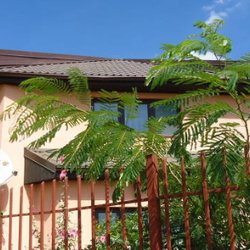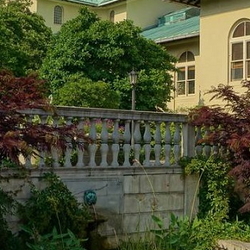(Editor's Note: This article was originally published on November 25, 2007. It is being repeated this week as we continue our invasive species contest. Your comments are welcome, but please be aware that authors of previously published articles may not be able to promptly respond to new questions or comments.)
The Mimosa Controversy
Towards fall, I noticed long brown seedpods. Traveling by car one day, I pulled off the road and scavenged a few of the pods. I planted a seed in a pot in early spring and was pleased when it grew into a fine young tree. The tree traveled with me when I moved down to north Florida and was planted in my yard. Only later did I find out that my tree was somewhat controversial. Looking up the plant in the Dave’s Garden PlantFiles, I found that I was cultivating the mimosa tree (Silk Tree, Pink Siris or Albizia julibrissin). This tree is one of the “Top Ten Plants” at Dave’s Garden. It's either an “invasive exotic species” or a “treasured garden heirloom” depending on one’s point of view. And people have strong points of view regarding Mimosa!! We gardeners are clearly conflicted in our approach to invasive plants.
Mimosa, Invasive Exotic
Introduced to this continent as an ornamental about 250 years ago, has established itself across much of the eastern US. As do most invasive plants, it reproduces prolifically. Numerous long brown flat seedpods are produced at summer's end and seeds sprout with ease. Additionally, the seeds are tough and can remain dormant for decades. Although most people know Mimosa tree from the edge of the highway or train track, apparently, it also enjoys the edges of forest and streams. The narrow strips of land bordering streams are apparently a crucial component of the ecosystem; providing key wildlife habitat, controlling flooding and erosion. Dense stands of mimosa reduce the sunlight available for native species, leading to deterioration in the plant diversity in these areas and degrading wildlife habitat. Mimosa tree has made it to the “least wanted list” of several agencies tracking invasive plants.
But It's So Pretty !
 | However, the mimosa tree (pictured left)i s a lovely plant with delicate fern like foliage . It grows rapidly and could quickly provide a screen or shade. The tree is not fussy about soil pH or fertility. Many people have fond childhood memories of the Mimosa tree, often reminiscing about the entertaining play with seedpods and the lovely scent of the pom-pom like pink blooms. Mimosa blossoms also attract butterfly and hummingbirds. As an additional temptation, a stunning bronze foliaged version is available. |
Does My One Tree Really Make A Difference?
 | I generally like nature and don’t really want to contribute to habitat degradation. Should I worry about my one mimosa tree when these trees are already all well established across the country? If this tree is such a problem, why are they available for sale at nurseries and on-line? I even noticed a specimen growing in the public gardens on the Mall in Washington, DC (pictured left). To add to the confusion, some municipalities restrict its use, while some have on their list of approved street trees! In most places owning this plant is not illegal and we are left to evaluate the appropriateness of this tree as a landscape plant for our individual yards. |
Mess-Mosa | Many people complain about the messiness of Mimosa (pictured left). The tree sheds in multiple stages; blossoms, followed by seedpods, then leaves, then sticks, which are either leaf petioles or twigs. The sticky, staining, brown paste formed by wet dropped blossoms is particularly noxious. Plants underneath a Mimosa can become coated and disintegrate under a thick carpet of brown flower goop. Positioning a Mimosa over a walkway or driveway may not be prudent. Mimosa also messily self-sows all over the yard. I am already constantly pulling Sable Palms, Loquats, Podocarpus and Carolina cherry seedlings out of the yard. Do I really want to confront a legion of mimosa babies as well? |
Just as many people overlook the mess for the mimosa’s scent. I can understand sparing an otherwise irritating plant due to scent. I suffer the annoyance of my gardenia’s thrips and the unattractive periodic yellowing of its leaves just to enjoy the scent of its blooms for a few weeks each year. However, I have sampled many different trees and, sadly, I can’t detect Mimosa scent. Why not sniff a mimosa next summer and see where you stand?
Disease Prone
|
| I have occasionally encountered a truly magnificent full-grown specimen of this tree. However, most specimens I see in costal north Florida are small, often lichen-covered and yellowed. Mimosa does particularly poorly as an isolated lawn specimen in my area. Many of these shabby coastal specimens probably reflect poor salt tolerance. The tree is reputed to be weak wooded and our violent summer storms may prune out larger specimens. Likely, many of our local trees are affected by Mimosa wilt. This disease is caused by the soil-borne fungus Fusarium oxysporum var. perniciosum, which invades trees through the root system. Orange to pinkish fruiting bodies may show on the surface of a terminal tree ready to disperse spores to the next victim. Even if the tree survives environmental challenges, they live only for 15 to 20 years. |
The Deciding Factor
 | My mimosa made seed pods (pictured left) for the first time this year. They gave me visions of crawling under the azaleas pulling sprouts. I worried about nearby natural areas. Though conflicted about taking out one of my plant babies, I am removing the Mimosa. Replacement candidates include a blue/purple flowered Vitex (Vitex agnus-castus 'Shoal Creek') or a native Easterm redbud (Cersis canadensis). I will miss my Mimosa but hopefully can find a better behaved tree to grow from a seed. |

















